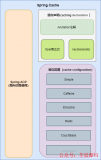前言
緩存可以通過將經(jīng)常訪問的數(shù)據(jù)存儲在內(nèi)存中,減少底層數(shù)據(jù)源如數(shù)據(jù)庫的壓力,從而有效提高系統(tǒng)的性能和穩(wěn)定性。我想大家的項目中或多或少都有使用過,我們項目也不例外,但是最近在review公司的代碼的時候?qū)懙暮艽狼襩ow, 大致寫法如下:
public User getById(String id) {
User user = cache.getUser();
if(user != null) {
return user;
}
// 從數(shù)據(jù)庫獲取
user = loadFromDB(id);
cahce.put(id, user);
return user;
}
其實Spring Boot 提供了強大的緩存抽象,可以輕松地向您的應(yīng)用程序添加緩存。本文就講講如何使用 Spring 提供的不同緩存注解實現(xiàn)緩存的最佳實踐。
啟用緩存@EnableCaching
現(xiàn)在大部分項目都是是SpringBoot項目,我們可以在啟動類添加注解@EnableCaching來開啟緩存功能。
@SpringBootApplication
@EnableCaching
public class SpringCacheApp {
public static void main(String[] args) {
SpringApplication.run(Cache.class, args);
}
}
既然要能使用緩存,就需要有一個緩存管理器Bean,默認情況下,@EnableCaching 將注冊一個ConcurrentMapCacheManager的Bean,不需要單獨的 bean 聲明。ConcurrentMapCacheManager將值存儲在ConcurrentHashMap的實例中,這是緩存機制的最簡單的線程安全實現(xiàn)。
自定義緩存管理器
默認的緩存管理器并不能滿足需求,因為她是存儲在jvm內(nèi)存中的,那么如何存儲到redis中呢?這時候需要添加自定義的緩存管理器。
- 添加依賴
<dependency>
<groupId>org.springframework.boot<span class="hljs-name"groupId>
<artifactId>spring-boot-starter-data-redis<span class="hljs-name"artifactId>
<span class="hljs-name"dependency>
- 配置Redis緩存管理器
@Configuration
@EnableCaching
public class CacheConfig {
@Bean
public RedisConnectionFactory redisConnectionFactory() {
return new LettuceConnectionFactory();
}
@Bean
public CacheManager cacheManager() {
RedisCacheConfiguration redisCacheConfiguration = RedisCacheConfiguration.defaultCacheConfig()
.disableCachingNullValues()
.serializeValuesWith(SerializationPair.fromSerializer(new GenericJackson2JsonRedisSerializer()));
RedisCacheManager redisCacheManager = RedisCacheManager.builder(redisConnectionFactory())
.cacheDefaults(redisCacheConfiguration)
.build();
return redisCacheManager;
}
}
現(xiàn)在有了緩存管理器以后,我們?nèi)绾卧跇I(yè)務(wù)層面操作緩存呢?
我們可以使用@Cacheable、@CachePut 或@CacheEvict 注解來操作緩存了。
@Cacheable
該注解可以將方法運行的結(jié)果進行緩存,在緩存時效內(nèi)再次調(diào)用該方法時不會調(diào)用方法本身,而是直接從緩存獲取結(jié)果并返回給調(diào)用方。

例子1:緩存數(shù)據(jù)庫查詢的結(jié)果。
@Service
public class MyService {
@Autowired
private MyRepository repository;
@Cacheable(value = "myCache", key = "#id")
public MyEntity getEntityById(Long id) {
return repository.findById(id).orElse(null);
}
}
在此示例中,@Cacheable 注解用于緩存 getEntityById()方法的結(jié)果,該方法根據(jù)其 ID 從數(shù)據(jù)庫中檢索 MyEntity 對象。
但是如果我們更新數(shù)據(jù)呢?舊數(shù)據(jù)仍然在緩存中?
@CachePut
然后@CachePut 出來了, 與 @Cacheable 注解不同的是使用 @CachePut 注解標注的方法,在執(zhí)行前不會去檢查緩存中是否存在之前執(zhí)行過的結(jié)果,而是每次都會執(zhí)行該方法,并將執(zhí)行結(jié)果以鍵值對的形式寫入指定的緩存中。@CachePut 注解一般用于更新緩存數(shù)據(jù),相當于緩存使用的是寫模式中的雙寫模式。
@Service
public class MyService {
@Autowired
private MyRepository repository;
@CachePut(value = "myCache", key = "#entity.id")
public void saveEntity(MyEntity entity) {
repository.save(entity);
}
}
@CacheEvict
標注了 @CacheEvict 注解的方法在被調(diào)用時,會從緩存中移除已存儲的數(shù)據(jù)。@CacheEvict 注解一般用于刪除緩存數(shù)據(jù),相當于緩存使用的是寫模式中的失效模式。

@Service
public class MyService {
@Autowired
private MyRepository repository;
@CacheEvict(value = "myCache", key = "#id")
public void deleteEntityById(Long id) {
repository.deleteById(id);
}
}
@Caching
@Caching 注解用于在一個方法或者類上,同時指定多個 Spring Cache 相關(guān)的注解。

例子1:@Caching注解中的evict屬性指定在調(diào)用方法 saveEntity 時失效兩個緩存。
@Service
public class MyService {
@Autowired
private MyRepository repository;
@Cacheable(value = "myCache", key = "#id")
public MyEntity getEntityById(Long id) {
return repository.findById(id).orElse(null);
}
@Caching(evict = {
@CacheEvict(value = "myCache", key = "#entity.id"),
@CacheEvict(value = "otherCache", key = "#entity.id")
})
public void saveEntity(MyEntity entity) {
repository.save(entity);
}
}
例子2:調(diào)用getEntityById方法時,Spring會先檢查結(jié)果是否已經(jīng)緩存在myCache緩存中。如果是,Spring 將返回緩存的結(jié)果而不是執(zhí)行該方法。如果結(jié)果尚未緩存,Spring 將執(zhí)行該方法并將結(jié)果緩存在 myCache 緩存中。方法執(zhí)行后,Spring會根據(jù)@CacheEvict注解從otherCache緩存中移除緩存結(jié)果。
@Service
public class MyService {
@Caching(
cacheable = {
@Cacheable(value = "myCache", key = "#id")
},
evict = {
@CacheEvict(value = "otherCache", key = "#id")
}
)
public MyEntity getEntityById(Long id) {
return repository.findById(id).orElse(null);
}
}
例子3:當調(diào)用saveData方法時,Spring會根據(jù)@CacheEvict注解先從otherCache緩存中移除數(shù)據(jù)。然后,Spring 將執(zhí)行該方法并將結(jié)果保存到數(shù)據(jù)庫或外部 API。
方法執(zhí)行后,Spring 會根據(jù)@CachePut注解將結(jié)果添加到 myCache、myOtherCache 和 myThirdCache 緩存中。Spring 還將根據(jù)@Cacheable注解檢查結(jié)果是否已緩存在 myFourthCache 和 myFifthCache 緩存中。如果結(jié)果尚未緩存,Spring 會將結(jié)果緩存在適當?shù)木彺嬷小H绻Y(jié)果已經(jīng)被緩存,Spring 將返回緩存的結(jié)果,而不是再次執(zhí)行該方法。
@Service
public class MyService {
@Caching(
put = {
@CachePut(value = "myCache", key = "#result.id"),
@CachePut(value = "myOtherCache", key = "#result.id"),
@CachePut(value = "myThirdCache", key = "#result.name")
},
evict = {
@CacheEvict(value = "otherCache", key = "#id")
},
cacheable = {
@Cacheable(value = "myFourthCache", key = "#id"),
@Cacheable(value = "myFifthCache", key = "#result.id")
}
)
public MyEntity saveData(Long id, String name) {
// Code to save data to a database or external API
MyEntity entity = new MyEntity(id, name);
return entity;
}
}
@CacheConfig
通過@CacheConfig 注解,我們可以將一些緩存配置簡化到類級別的一個地方,這樣我們就不必多次聲明相關(guān)值:
@CacheConfig(cacheNames={"myCache"})
@Service
public class MyService {
@Autowired
private MyRepository repository;
@Cacheable(key = "#id")
public MyEntity getEntityById(Long id) {
return repository.findById(id).orElse(null);
}
@CachePut(key = "#entity.id")
public void saveEntity(MyEntity entity) {
repository.save(entity);
}
@CacheEvict(key = "#id")
public void deleteEntityById(Long id) {
repository.deleteById(id);
}
}
Condition & Unless
condition作用:指定緩存的條件(滿足什么條件才緩存),可用SpEL表達式(如#id>0,表示當入?yún)?id 大于 0 時才緩存)unless作用 : 否定緩存,即滿足unless指定的條件時,方法的結(jié)果不進行緩存,使用unless時可以在調(diào)用的方法獲取到結(jié)果之后再進行判斷(如 #result == null,表示如果結(jié)果為 null 時不緩存)
//when id >10, the @CachePut works.
@CachePut(key = "#entity.id", condition="#entity.id > 10")
public void saveEntity(MyEntity entity) {
repository.save(entity);
}
//when result != null, the @CachePut works.
@CachePut(key = "#id", condition="#result == null")
public void saveEntity1(MyEntity entity) {
repository.save(entity);
}
清理全部緩存
通過allEntries、beforeInvocation屬性可以來清除全部緩存數(shù)據(jù),不過allEntries是方法調(diào)用后清理,beforeInvocation是方法調(diào)用前清理。
//方法調(diào)用完成之后,清理所有緩存
@CacheEvict(value="myCache",allEntries=true)
public void delectAll() {
repository.deleteAll();
}
//方法調(diào)用之前,清除所有緩存
@CacheEvict(value="myCache",beforeInvocation=true)
public void delectAll() {
repository.deleteAll();
}
SpEL表達式
Spring Cache注解中頻繁用到SpEL表達式,那么具體如何使用呢?
SpEL 表達式的語法

Spring Cache可用的變量

最佳實踐
通過Spring緩存注解可以快速優(yōu)雅地在我們項目中實現(xiàn)緩存的操作,但是在雙寫模式或者失效模式下,可能會出現(xiàn)緩存數(shù)據(jù)一致性問題(讀取到臟數(shù)據(jù)),Spring Cache 暫時沒辦法解決。最后我們再總結(jié)下Spring Cache使用的一些最佳實踐。
- 只緩存經(jīng)常讀取的數(shù)據(jù):緩存可以顯著提高性能,但只緩存經(jīng)常訪問的數(shù)據(jù)很重要。很少或從不訪問的緩存數(shù)據(jù)會占用寶貴的內(nèi)存資源,從而導(dǎo)致性能問題。
- 根據(jù)應(yīng)用程序的特定需求選擇合適的緩存提供程序和策略。
SpringBoot支持多種緩存提供程序,包括Ehcache、Hazelcast和Redis。 - 使用緩存時請注意潛在的線程安全問題。對緩存的并發(fā)訪問可能會導(dǎo)致數(shù)據(jù)不一致或不正確,因此選擇線程安全的緩存提供程序并在必要時使用適當?shù)耐綑C制非常重要。
- 避免過度緩存。緩存對于提高性能很有用,但過多的緩存實際上會消耗寶貴的內(nèi)存資源,從而損害性能。在緩存頻繁使用的數(shù)據(jù)和允許垃圾收集不常用的數(shù)據(jù)之間取得平衡很重要。
- 使用適當?shù)木彺嬷鸪霾呗浴J褂镁彺鏁r,重要的是定義適當?shù)木彺嬷鸪霾呗砸源_保在必要時從緩存中刪除舊的或陳舊的數(shù)據(jù)。
- 使用適當?shù)木彺骀I設(shè)計。緩存鍵對于每個數(shù)據(jù)項都應(yīng)該是唯一的,并且應(yīng)該考慮可能影響緩存數(shù)據(jù)的任何相關(guān)參數(shù),例如用戶 ID、時間或位置。
- 常規(guī)數(shù)據(jù)(讀多寫少、即時性與一致性要求不高的數(shù)據(jù))完全可以使用 Spring Cache,至于寫模式下緩存數(shù)據(jù)一致性問題的解決,只要緩存數(shù)據(jù)有設(shè)置過期時間就足夠了。
- 特殊數(shù)據(jù)(讀多寫多、即時性與一致性要求非常高的數(shù)據(jù)),不能使用 Spring Cache,建議考慮特殊的設(shè)計(例如使用 Cancal 中間件等)。
-
數(shù)據(jù)存儲
+關(guān)注
關(guān)注
5文章
971瀏覽量
50909 -
數(shù)據(jù)庫
+關(guān)注
關(guān)注
7文章
3799瀏覽量
64390 -
代碼
+關(guān)注
關(guān)注
30文章
4788瀏覽量
68612 -
spring
+關(guān)注
關(guān)注
0文章
340瀏覽量
14343 -
SpringBoot
+關(guān)注
關(guān)注
0文章
173瀏覽量
179
發(fā)布評論請先 登錄
相關(guān)推薦
CPU Cache是如何保證緩存一致性的?

高速緩存Cache介紹
什么是緩存Cache
高速緩存(Cache),高速緩存(Cache)原理是什么?
Linux內(nèi)核Page Cache和Buffer Cache兩類緩存的作用及關(guān)系如何

推薦兩個工作流的springboot項目
如何在SpringBoot項目中實現(xiàn)動態(tài)定時任務(wù)
如何在SpringBoot中解決Redis的緩存穿透等問題
SpringBoot項目中使用緩存的正確方法

Springboot項目的集成以及具體使用及配置

什么是springBoot業(yè)務(wù)組件化開發(fā)?談?wù)?b class='flag-5'>SpringBoot業(yè)務(wù)組件化





 如何正確使用SpringBoot項目中緩存Cache
如何正確使用SpringBoot項目中緩存Cache












評論